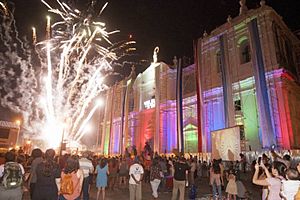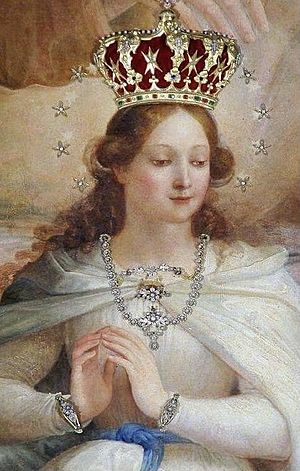Feast of the Immaculate Conception facts for kids
The Solemnity of the Immaculate Conception is a special day that celebrates the belief that Mary, the mother of Jesus, was born without original sin. This means she was kept pure from the very beginning of her life. It happens every year on 8 December. This date is exactly nine months before Mary's birthday, which is celebrated on 8 September.
This day is one of the most important celebrations for Mary in the Roman Catholic Church. Many countries see it as a very special day. These include Argentina, Brazil, Chile, Italy, Korea, Nicaragua, Paraguay, the Philippines, Spain, the United States, and Uruguay. Portugal also honors Mary as their patroness on this day.
Since 1953, the Pope visits the Column of the Immaculate Conception in Rome. He goes there to pray and remember this important event.
The feast became a holy day of obligation on 6 December 1708. This means Catholics are expected to attend Mass on this day. Pope Clement XI made this rule official. In many Catholic countries, people celebrate with church services, parades, fireworks, and special food.
Contents
History of the Celebration
The idea of Mary being pure from her conception started very early. In the Eastern Church, people celebrated a "Feast of the Conception of the Most Holy and All Pure Mother of God" on 9 December. This might have begun as early as the 5th century in Syria. At first, this feast focused on Saint Anne, Mary's mother. It was called "conception of Saint Anne, the ancestress of God." By the 7th century, this feast was well-known in the East.
The Eastern Church called Mary Achrantos, meaning "spotless" or "immaculate." However, they didn't have the same exact teaching about original sin as the Western Church. The feast came to the Western Church in the 8th century. It spread from Southern Italy to Normandy, and then to England, France, Germany, and Rome.
In 1568, Pope Pius V changed the prayer books. He removed a special prayer for the Immaculate Conception for most of the Church. Instead, he used a prayer for Mary's birth, just changing "Nativity" to "Conception."
On 6 December 1708, Pope Clement XI made the feast a holy day of obligation. He wanted all Catholics to celebrate it. He also asked for his official order to be copied and shared widely.
Before Pope Pius IX officially defined the Immaculate Conception in 1854, most prayer books called it the "Feast of the Conception of the Blessed Virgin Mary." The prayers focused on Mary's conception, not so much on the idea of her being free from original sin.
The idea of Mary's conception being "immaculate" became more common in the 11th century. In the 15th century, Pope Sixtus IV encouraged the festival. He allowed people to believe in the Immaculate Conception or to question it. The Council of Trent later supported this view.
The Roman Catholic Church's View

On 8 December 1854, Pope Pius IX made an important statement called Ineffabilis Deus. He declared:
"The most Blessed Virgin Mary, from the very first moment she was conceived, was kept free from all stain of original sin. This was a special gift from God, given because of Jesus Christ, who saves all people."
In the Catholic Church, if 8 December falls on a Sunday, the celebration is usually moved to the next Monday. This is because Advent Sundays are very important.
Anglican Communion
In the Church of England, the "Conception of the Blessed Virgin Mary" is a "Lesser Festival" on 8 December. However, they do not specifically say that Mary was "sinless" or "immaculate" from her conception. Other Anglican churches have similar practices.
Oriental Orthodoxy
The Ethiopian Orthodox Tewahedo Church celebrates the Feast of the Immaculate Conception on August 13. They believe Mary was born pure and without fault.
Eastern Orthodoxy
The Eastern Orthodox Churches do not accept the Roman Catholic teaching of the Immaculate Conception in the same way. They celebrate 9 December as the "Feast of the Conception by Saint Anne of the Most Holy Theotokos" (Mother of God).
Orthodox Christians believe Mary was full of God's grace from her conception. They see her as the Mother of God. However, their understanding of "original sin" is different from Catholics. They do not teach that Mary was conceived without original sin in the same way. But they do believe Mary was "all-holy" and never sinned during her life.
The Orthodox feast is not exactly nine months before Mary's birth (8 September). It is one day later. This feast is not one of the biggest celebrations in the Orthodox Church.
Public Holiday Status


The Solemnity of the Immaculate Conception is a public holiday in many countries and territories:
 Andorra
Andorra Argentina
Argentina Austria
Austria Chile
Chile Colombia — People cook special foods to honor this day.
Colombia — People cook special foods to honor this day. Equatorial Guinea
Equatorial Guinea Guam (USA)
Guam (USA) Italy — It has been a national holiday since 1953. The Pope visits the Column of the Immaculate Conception in Rome. This day also marks the start of the Christmas season in Italy.
Italy — It has been a national holiday since 1953. The Pope visits the Column of the Immaculate Conception in Rome. This day also marks the start of the Christmas season in Italy. Liechtenstein
Liechtenstein Macau, China — It became a legal holiday in 2001.
Macau, China — It became a legal holiday in 2001. Malta
Malta Monaco — Celebrated with food, honoring mothers and grandmothers.
Monaco — Celebrated with food, honoring mothers and grandmothers. Nicaragua – Celebrated with local parades and religious processions.
Nicaragua – Celebrated with local parades and religious processions. Panama – Celebrated as Mother's Day.
Panama – Celebrated as Mother's Day. Paraguay
Paraguay Peru
Peru Philippines – A non-working public holiday honoring the Virgin Mary as the country's patroness. It became a permanent holiday in 2017.
Philippines – A non-working public holiday honoring the Virgin Mary as the country's patroness. It became a permanent holiday in 2017. Portugal
Portugal San Marino
San Marino Seychelles
Seychelles Spain — A national holiday since 1760, made official by Pope Clement XIII.
Spain — A national holiday since 1760, made official by Pope Clement XIII. Switzerland — 13 out of 26 cantons have made this a public holiday.
Switzerland — 13 out of 26 cantons have made this a public holiday. East Timor
East Timor Vatican
Vatican Venezuela
Venezuela
See also
 In Spanish: Fiesta de la Inmaculada Concepción para niños
In Spanish: Fiesta de la Inmaculada Concepción para niños
- Feast of the Conception of the Virgin Mary
- Patronages of the Immaculate Conception

